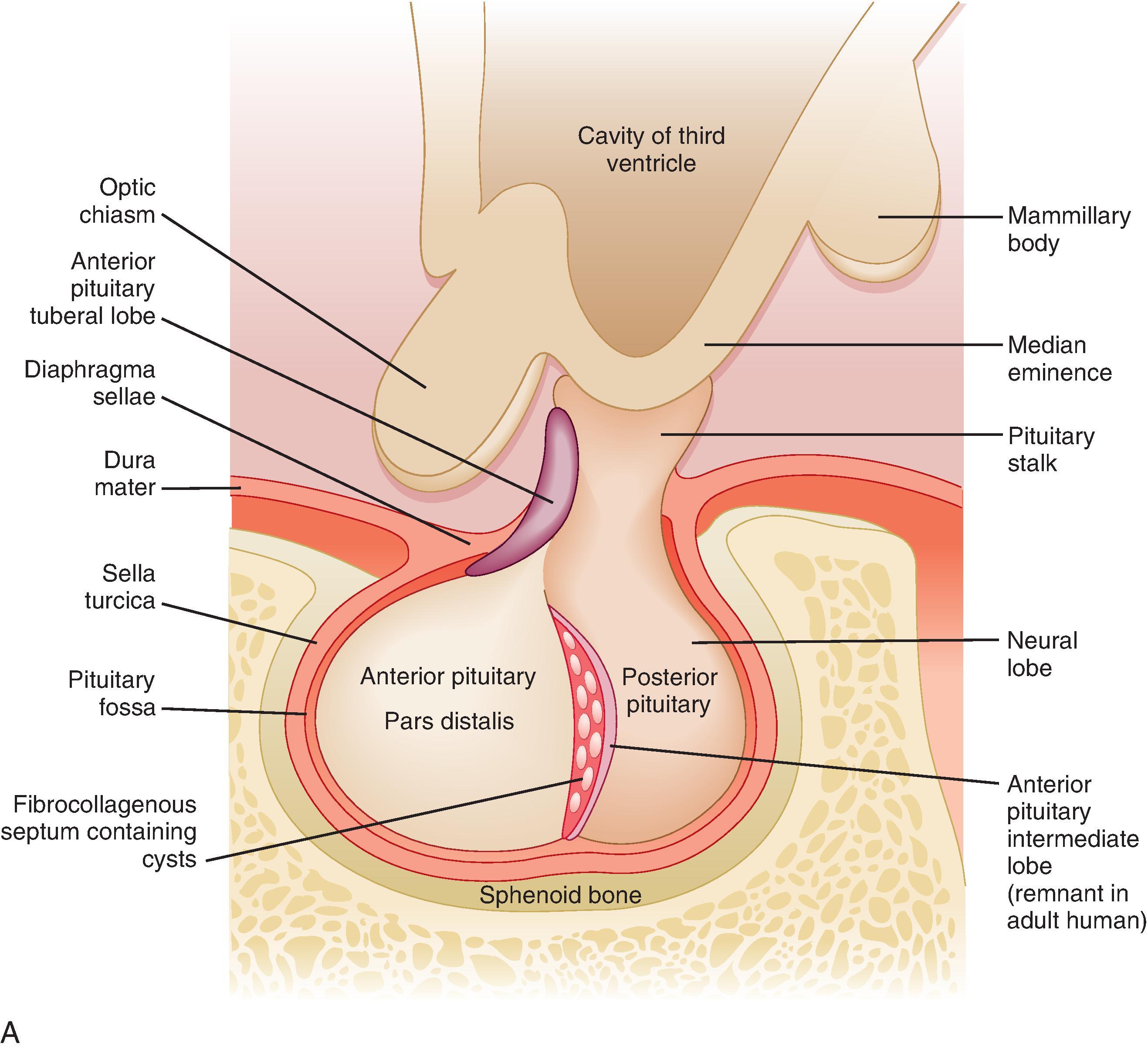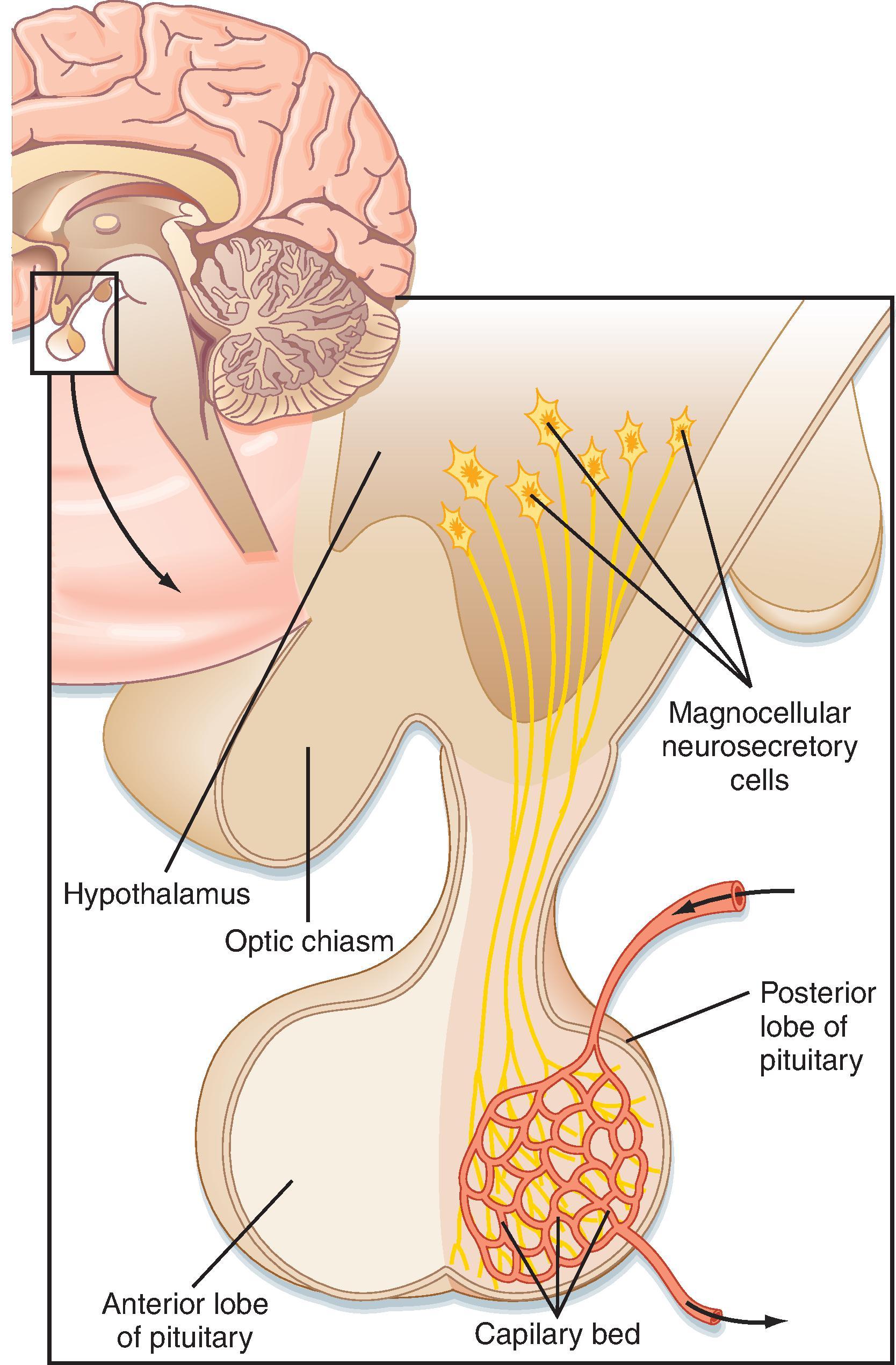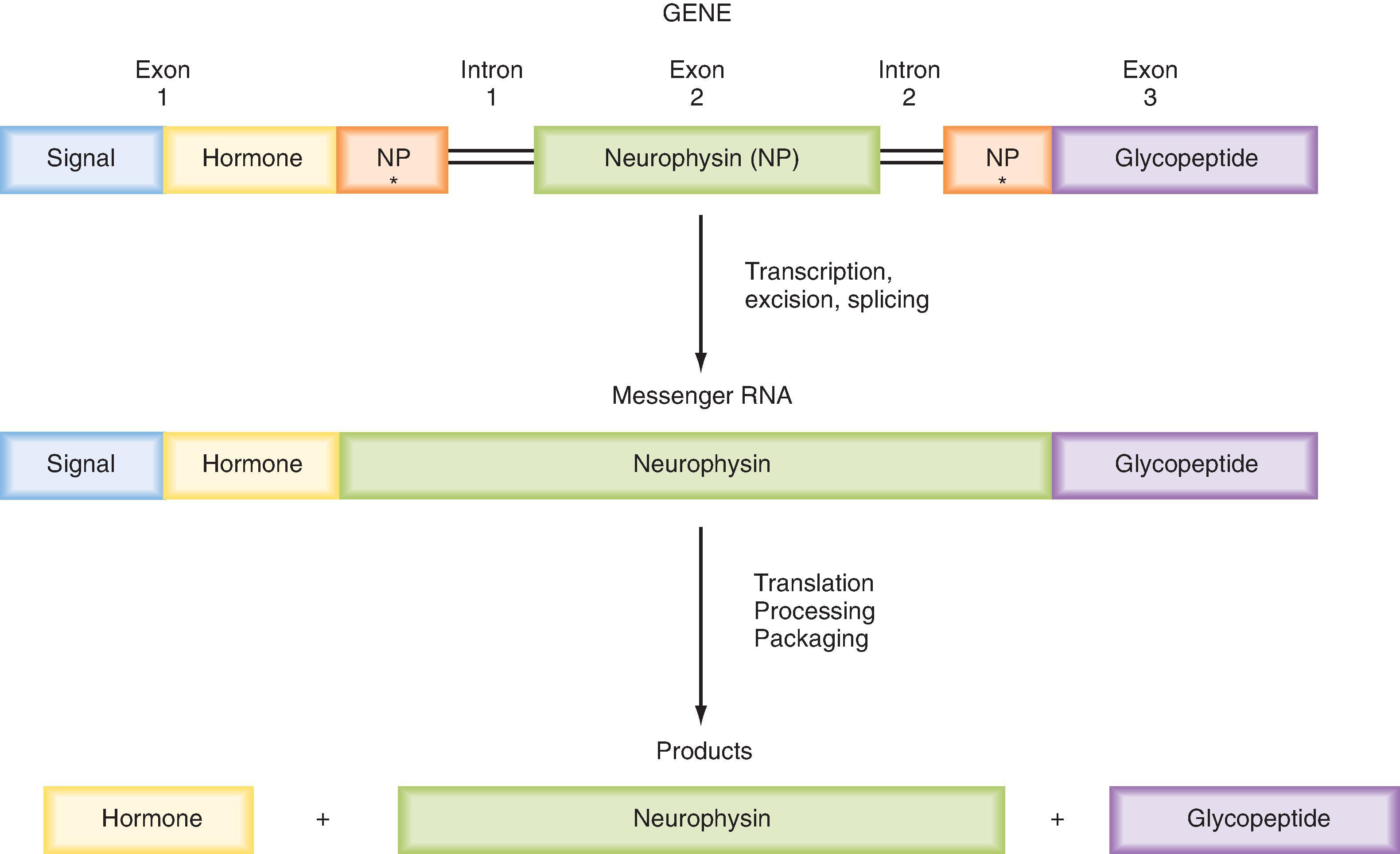Physical Address
304 North Cardinal St.
Dorchester Center, MA 02124
Upon completion of this chapter, the student should be able to answer the following questions :
Describe the structure and composition of the pituitary gland and its structural and functional relationship to magnocellular and parvocellular hypothalamic neurons.
Discuss the mechanisms by which the neurohormones antidiuretic hormone (ADH) and oxytocin are synthesized, transported, and released by magnocellular neurons.
Diagram a basic scheme illustrating the components and feedback loops of a typical endocrine axis, including central input, hypothalamic-releasing factors, pituitary hormones, and a peripheral endocrine gland. Explain the concept of a set point.
List the endocrine cell types of the adenohypophysis and the tropic hormones they produce, noting hormones that share a common subunit.
Contrast the axes of somatotropes and lactotropes with the classic endocrine axes and explain how they differ.
Discuss the actions of growth hormone (GH) and insulin-like growth factor I (IGF-I) in the regulation of growth, and the role of GH in the fasted state.
Describe the role of prolactin in the initiation and maintenance of lactation.
The pituitary gland (also called the hypophysis ) is a small (≈0.5 g in weight) yet complex endocrine structure at the base of the forebrain ( Fig. 41.1 ). It is composed of an epithelial component called the adenohypophysis and a neural structure called the neurohypophysis. The adenohypophysis is composed of five cell types that secrete six hormones. The neurohypophysis releases several neurohormones. All endocrine functions of the pituitary gland are regulated by the hypothalamus and by negative- and positive-feedback loops.
Microscopic examination of the pituitary reveals two distinct types of tissue: epithelial and neural ( Fig. 41.2 ). The epithelial portion of the human pituitary gland is called the adenohypophysis. The adenohypophysis makes up the anterior portion of the pituitary and is often referred to as the anterior lobe of the pituitary, and its hormones are referred to as anterior pituitary hormones. The adenohypophysis is composed of three parts: (1) the pars distalis, which makes up about 90% of the adenohypophysis; (2) the pars tuberalis, which wraps around the stalk; and (3) the pars intermedia, which regresses and is absent in adult humans.

The neural portion of the pituitary is called the neurohypophysis , which represents a downgrowth of the hypothalamus. The most inferior portion of the neurohypophysis is called the pars nervosa, also called the posterior lobe of the pituitary (or simply posterior pituitary ). At the superior end of the neurohypophysis, a funnel-shaped swelling called the median eminence develops. The portion of the neurohypophysis that extends from the median eminence down to the pars nervosa is called the infundibulum. The infundibulum and the pars tuberalis make up the pituitary stalk—a physical connection between the hypothalamus and pituitary gland (see Fig. 41.2 ).
The pituitary gland (anterior and posterior lobes) is situated within a depression of the sphenoid bone called the sella turcica. Generally, tumors that arise in the pituitary are only able to expand in one direction, up into the brain and against the optic chiasma. Thus, any increase in size of the pituitary is commonly associated with visual field defects and headaches. The sella turcica is sealed off from the brain by a membrane called the diaphragma sellae.
The pars nervosa is a neurovascular structure that is the site of neurohormone release adjacent to a rich capillary bed. The peptide hormones that are released are antidiuretic hormone (ADH, or arginine vasopressin) and oxytocin. The cell bodies of the neurons that project to the pars nervosa are located in the supraoptic nuclei (SON) and paraventricular nuclei (PVN) of the hypothalamus (a nucleus refers to a collection of neuronal cell bodies residing within the central nervous system [CNS]; a ganglion is a collection of neuronal cell bodies residing outside the CNS). The large cell bodies of these neurons are described as magnocellular, and they project axons down the infundibular stalk as the hypothalamohypophyseal tracts. Individual magnocellular neurons are hormone specific, producing either ADH or oxytocin. These axons terminate in the pars nervosa ( Fig. 41.3 ). In addition to axonal processes and termini from the SON and PVN, there are glial-like support cells called pituicytes. The posterior pituitary is extensively vascularized and the capillaries are fenestrated, thereby facilitating diffusion of hormones into the systemic circulation.

ADH and oxytocin are small peptides (nine amino acids) that differ in only two amino acids, yet they have limited overlapping activity. ADH and oxytocin are synthesized as preprohormones ( Fig. 41.4 ). Each prohormone harbors the structure of oxytocin or ADH and a co-secreted peptide, either neurophysin I (associated with ADH) or neurophysin II (associated with oxytocin). These preprohormones are called preprovasophysin and preprooxyphysin. The N-terminal signal peptide is cleaved as the peptide is transported into the endoplasmic reticulum. In cell bodies within the SON and PVN, the prohormones are packaged in the endoplasmic reticulum and Golgi apparatus in membrane-bound secretory granules ( Fig. 41.5 ). The secretory granules are conveyed through a “fast” (i.e., millimeters per hour) adenosine triphosphate (ATP)-dependent axonal transport mechanism down the infundibular stalk to axonal termini in the pars nervosa. During transit of the secretory granule, the prohormones are proteolytically cleaved to produce equimolar amounts of hormone and neurophysin. Secretory granules containing fully processed peptides are stored in the axonal termini. Expansions of the termini due to the presence of stored secretory granules can be observed by light microscopy and are termed Herring bodies.

![Fig. 41.5, Synthesis, processing, and transport of preprovasopressin. Human ADH (also called arginine vasopressin [AVP] ) is synthesized in the hypothalamic magnocellular cell bodies and packaged into neurosecretory granules. During intraaxonal transport of the granules down the infundibular process to the pars nervosa, provasopressin is proteolytically cleaved into the active hormone (AVP = ADH), neurophysin (NP) , and a C-terminal glycoprotein (GP) . NP arranges into tetramers that bind five AVP molecules. All three fragments are secreted from axonal termini in the pars nervosa (posterior pituitary) and enter the systemic blood. Only AVP (ADH) is biologically active. SP , signal peptide. Fig. 41.5, Synthesis, processing, and transport of preprovasopressin. Human ADH (also called arginine vasopressin [AVP] ) is synthesized in the hypothalamic magnocellular cell bodies and packaged into neurosecretory granules. During intraaxonal transport of the granules down the infundibular process to the pars nervosa, provasopressin is proteolytically cleaved into the active hormone (AVP = ADH), neurophysin (NP) , and a C-terminal glycoprotein (GP) . NP arranges into tetramers that bind five AVP molecules. All three fragments are secreted from axonal termini in the pars nervosa (posterior pituitary) and enter the systemic blood. Only AVP (ADH) is biologically active. SP , signal peptide.](https://storage.googleapis.com/dl.dentistrykey.com/clinical/TheHypothalamusandPituitaryGland/3_3s20B9780323847902000412.jpg)
ADH and oxytocin are released from the pars nervosa in response to stimuli that are primarily detected at the cell body and its dendrites in the SON and PVN. These stimuli are mainly in the form of neurotransmitters released from hypothalamic interneurons. With sufficient stimulus the neurons will depolarize and propagate an action potential down the axon. At the axonal termini the action potential increases intracellular [Ca ++ ] and results in a stimulus-secretion response, with exocytosis of ADH or oxytocin along with neurophysins into the extracellular fluid of the pars nervosa (see Fig. 41.5 ). Hormones and neurophysins enter the peripheral circulation, and both can be measured in blood.
Become a Clinical Tree membership for Full access and enjoy Unlimited articles
If you are a member. Log in here